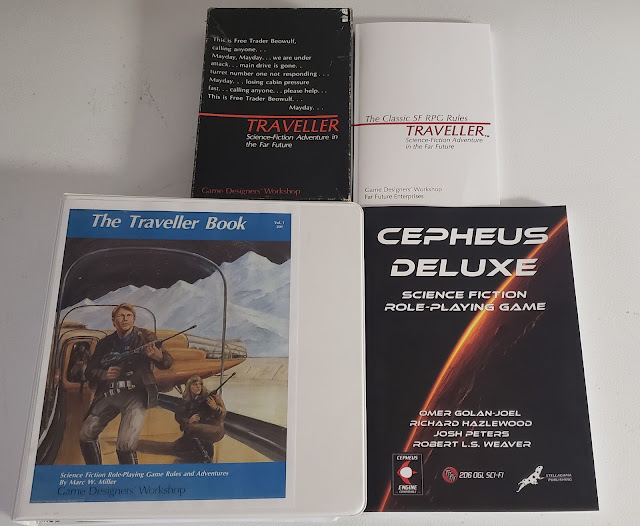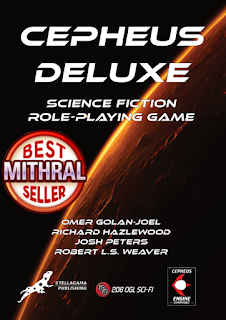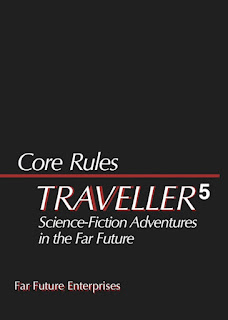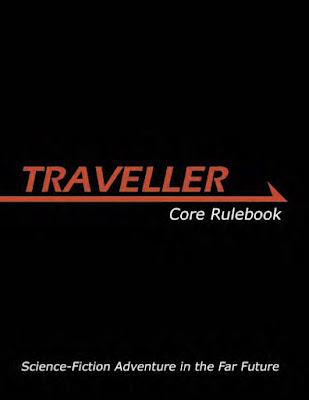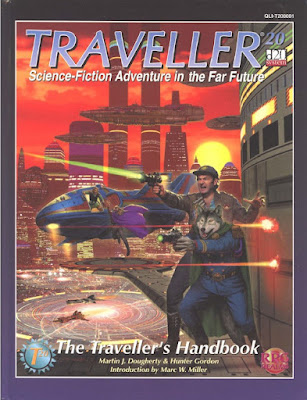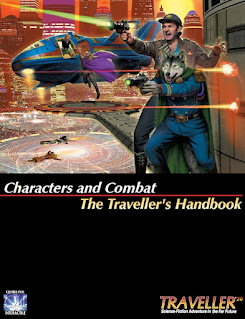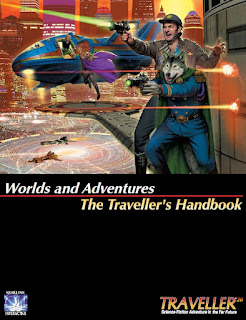We are now in another new decade. In fact a new century and a new millennium in fact. And of course another new edition of Traveller. Interestingly enough we are now 25 years out from the Little Black Books. But we are now nearing the end height of the d20 boom.
Traveler, for the first time in its history, is now using the same system as Dungeons & Dragons.
Traveller for d20, also called Traveller 20 or even T20 used the d20 system under the OGL and d20 STL.
Since this is the 20th day of SciFi month, let's do Traveller for d20!
There are two versions of this game, one out in 2002, which I remember was a single hardcover book. The other, available from DriveThruRPG is the 2007 edition and made up of three books (and a handbook). I had the 2002 version briefly but ended selling it off in an auction. Why? I can't recall. I had a baby and another one on the way, I bet I needed money.
Both versions have similar cover art.
For the purposes of this review, I am going to consider the 2006-7 version from DriveThruRPG and from Far Future Enterprises where I got my copy from.
Traveller20 Core Rules Set (2006-7)
PDF. Four files. Color cover art, black & white interior art.
Ok. I want to start with this. I like d20. I do. My favorite version of the Star Wards RPG is Wizard's Revised d20 version. I know that sounds like blasphemy to so many, but I don't care. Star Wars and D&D are so wrapped up into my childhood that bringing them together under one system was a no-brainer for me. Now if I can add some Traveller bits? Well I don't know if I can just yet, but the idea is so tempting, so tantalizing I just can't help it. Seriously what could be more Summer of 1977 than Star Wars + D&D + Traveller? What does that mean for you? Well. I am likely to cut this edition a lot of slack. Maybe even to the point of excusing some things I shouldn't. Forewarned is forearmed.
The Traveller's GuidebookPDF. 234 Pages, Color cover, black & white interior art with blue accents.
This is the "Book 0" OR the Book 4 of the 2006-7 Traveller d20 line. This book covers all the basics for the Traveller Player.
We get out Introduction which tells us what we are in for here. It is written for the point of view of anyone new to RPGs or new to Traveller (any version).
We get brief overviews of the d20 mechanic. How to set your Difficulty Levels (DCs) and even a little on success levels.
Character Creation is next. What follows is pretty standard for all d20 games. Roll abilities, choose races, select classes, set skills, add feats, roll up hitpoints. This is Traveller so there is a bit more added on.
D&D/d20 has six Character Abilities. Traveller has six. T20 has nine. These are Strength, Dexterity, Constitution, Intelligence, Education, Wisdom, Charisma, Social Standing, and Psionic Strength. Ok a mix of both systems. Not exactly what I would have done, but hey. Ability scores are d20 standard, modifiers are as well.
Hitpoints are split between Stamina and Lifeblood. Or what other games might call wound points and health points. One slows you down the other represents how much you have till you die. Loosing either is not good.
Races are discussed and the standard humans are given with variations. You can also choose Vargr, Aslan, Ursa, and Virushi.
Since this is Traveller you have your homeworld to consider. There are plenty of random tables to help you figure this all out. Tech Levels from previous editions remain here. It's a nice touch of course. Also you have your prior history, or what you did before you decided to live the glamorous life of a Traveller. Turns of service enter here with various paths and what that all means in terms of your character (background, credit earned, and skills). I am not sure but it seems like there are a lot of careers here. More than other editions.
Once that is figured out you can choose a class. XP values are the same as D&D 3.x so that is easy enough. There are 12 core classes: Academic, Athlete, Barbarian, Belter, Entertainer, Martial Artist, Mercenary, Merchant, Noble, Professional, Rogue, and Traveller. Nine "Service" Classes: Army, Convict, Corsair, Flyer, Law Enforcement, Marine, Navy, Sailor, and Scout. And eight Prestige Classes: Diplomat, Engineer, Medic, Ace Pilot, Ancients Hunter, Big Game Hunter, Psionicist, and TAS Field Reporter.
Skills are covered and as expected there are a lot of them. A lot. Nearly 30 pages worth. Same goes for Feats (this is d20 after all). Now I prefer a smaller list of skills myself, but I see why the authors did what they did.
Equipment and Starting Funds cover the next 40 pages or so. Imperial Credits are still good here!
Combat is the d20 system with a few twists, but nothing the average D&D 3.x+ player couldn't figure out. The covers personal, vehicle and ship combat.
Adventuring covers quite a lot from what the characters do, living expenses, environments and their dangers, weather dangers, movement, vision, and on to Psionics (which really should be it's own chapter).
We now get into what could be reasonably called the Traveller Black Books of d20.
Book 1: Characters and CombatPDF. 209 Pages, Color cover, black & white, and color interior art.
I will admit I am confused. This book looks older than the "Book 0" above. No problem. Ok. So I get the idea these textbooks are actually separate from the first one. Not sure what the logic here is, but works for me. I'll take these three books as a group, like the Little Black Books of old.
We start out with some game fiction. Move right on to an introduction from Marc W. Miller, but I think that is all he did for this particular version. This moves on to the Introduction to RPGs section and about Traveller in particular. So while it is similar to the book above it also goes into far more detail.
Characters cover character creation.
There is an overview with page references to where they are detailed later in this book. Most interestingly there are now eight (8) Abilities. The standard d20 ones plus Education (EDU) and Social Standing (SOC).
You generate your abilities first, examples are given of how EDU and SOC work in the game. Determine your race/species included here are humans (with sub-types), Vargr, Aslan, Luriani, Sydites, Ursa, and Virushi. Mentioned ar the Droyne, Hivers, and K'Kree.
As always your homeworld stats are determined and character adjusted as needed. This also helps with skills and what classes are available to you.
Classes are next and there are a lot of them. This time they are better explained. We have the core classes: Academic, Barbarian, Belter, Mercenary, Merchant, Noble, Professional, Rogue, and Traveller. The Service Classes: Army, Marine, Navy, and Scout. And Prestige Classes: Ace Pilot, Big Game Hunter, and TAS Field Reporter. Classes work like the d20 standard.
I do admit I have a desire to run a game with TAS field reporters. If nothing else this is giving me a load of ideas for my Star Trek: Mercy campaign.
Skills are up and we also get a note that this section is Open Game Content. Nice touch. There are quite a lot of skills here, more than the d20 standard of the time. A lot of these are also limited to particular classes or backgrounds. Unlike standard d20 and more like some other games, some skills can be used with more than one ability. Pilot for example can be INT or DEX. I think my favorite addition though is the "Dealing with Bureaucrats" DC table. As expected this section is rather large.
Feats (this is d20 after all) is also a long section. There are also some Final Details to figure out like age, height, and weight.
Oddly, but maybe it makes sense, Prior History is after all of this. Reading through is does actually since it modifies what the character is like. In truth it is like a rather robust "Backgrounds" from D&D 5th Edition, just 10+ years before that.
Combat is up. The book says that combat is pretty much the same as d20 standard except in a few cases. Mostly Traveller universe specific examples. Where things are different it is noted.
After combat, the Prestige Classes are covered. And at the end as always (more or less) is Psionics.
The Appendices follow. Their page numbers start as if all three books are combined. Nice really. So Appendix I starts on page 426. The last page is the OGL and Product Identity information.
Book 2: Equipment and DesignPDF. 164 Pages, Color cover, black & white interior art.
I just want to say right now that I am loving this Classic Traveller presentation of the Traveller 20 rules. I wish I had a POD of this.
This book continues, page numbers and all, from Book 1.
This book covers all the Technology and Equipment (about two dozen pages), the design of vehicles and starships, and some standard designs. All of it is largely what you would expect it to be.
Technology and Equipment. This discusses various TLs (Technology Levels) and the character "shopping list" so lots of weapons. We do have sections of drugs, medical care, food and living expenses, as well as cybertechnology (somewhat that started in Traveller just a decade ago) and cloning. Interestingly enough I did not see a lot on robots save that they can be built like vehicles. I do appreciate the conservation of rule space here, but more might have been nice.
Computers are more advanced, but you are all sick of me harping on that.
The Appendices repeat here as well as the OGL information.
Book 3: Worlds and AdventuresPDF. 107 Pages, Color cover, black & white interior art.
Ok, I have to admit I am enjoying this system.
This is the smallest of the three.
This book covers Travelling (Chapter 14), Starship Encounters (Chapter 15), Universe and World development (Chapter 16), Campaigns (17), and Traveller Adventures (Chapter 18).
The design here is one of characters living in a giant Galactic Imperium that is full of adventure and lite on the details of the Imperium itself. Oh there is information here on it anyone with any knowledge of Traveller can easily fill in the blanks. The focus of this game though is more like Classic Traveller, on the characters and what they do. There is more here than Classic Traveller, but not as much as say MegaTraveller.
I can gather from reading that this takes place sometime prior to the timeline of the LBBs, before 1000. But not much more.
--
Ok so this bundle has two separate versions of the T20 game. For my money, I would rather the Three Books and add in details from The Traveller's Guidebook where needed.
The Three Books cover the same material as The Traveller's Guidebook save for where the TGB goes into additions (more classes, more abilities). I am not 100% convinced that the additions to TGB are better.
I am not going to lie. I like the 3.x d20 system, warts and all. I like the idea of a huge Galactic Empire. So if I am going to play a non-Trek game then some flavor of d20 is likely going to be my choice.
Call me crazy, but I like this one.
Part of me wants to find a copy of the Traveller d20 dead tree book online to buy another part of me wants to print out what I have to put into a binder with other d20-based SciFi games. I know there is d20 Starfleet Battles / Prime Directive and more.



